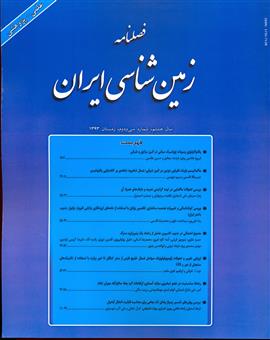مه¬موج احتمالي در جنوب كاسپين حاصل از رخداد يك زمينلرزه سترگ
محورهای موضوعی :
کلید واژه: زمینلرزه کاسپین گسل آستارا گسل خزر مهموج,
چکیده مقاله :
حوضه جنوب كاسپين با بلندي هاي البرز مركزي در جنوب و كوه هاي تالش در سوي جنوب باختري در برگرفته مي شود. بلندي هاي البرز مركزي با راستاي خاوري- باختري و تالش با راستاي شمالي- جنوبي بخشي از كمربند لرزهاي آلپ- هيماليا به شمار مي آيند. گسله خزر (كاسپين) با درازايي بیش از 450 كيلومتر و گسله آستارا با درازاي 110 كيلومتر به -عنوان مرز شمالي البرز مركزي و مرز خاوري كوه هاي تالش در جايي كه سنگ هاي مزوزوئيك و پالئوژن بر روي نهشته هاي جوان دشت ساحلي جنوب كاسپين رانده شده، مشاهده مي گردند. بر پايه پژوهش هاي ريخت زمين ساختي و پارينهلرزه-شناسي گمان مي رود كه بخش بزرگي از كوتاهشدگي كنوني در البرز بر روي دامنه شمالي كوه و در امتداد پهنه گسلي خزر متمركز باشد. چنين مرزي را مي توان به عنوان پيشاني همبري بين البرز و حوضه كاسپين جنوبي تفسير نمود. مطالعات اخير چينه نگاري نهشته هاي هلوسن پليوستوسن در خاور دره هراز نشانگر نرخ فروكاوي برابر mm/yr 25/1در 12 هزار سال گذشته است. با فرض ارتباط فروكاوي با عملكرد مولفه شاقولي بر روي گسله خزر، كوتاه شدگي شمالي- جنوبي بر روي اين گسل با شيب35 به سوي جنوب برابر با mm/yr 5/2 برآورد مي گردد كه تنها يك دهم از ميزان كل كوتاه-شدگي ( mm/yr2±5) البرز مي باشد. بر پايه مشاهدات لرزه اي و ژئوفيزيكي گسله خزر نيز چون گسله آستارا به عنوان سامانه فعال و اصلي در لبه جنوب باختري حوضه كاسپين جنوبي به صورت سامانه گسلي پيشرونده به زير دريا كشيده شده است. رخداد زمينلرزه هاي بسياري را مي توان نتيجه جنبش شاخه هاي گوناگون اين سامانه هاي گسلي در پهنه هاي خشكي و آبي حوضه كاسپين جنوبي دانست. بر پايه هندسه حوضه، گسله هاي پيشرونده به سوي شمال يا خاور و شيب كرانه اي، افزونبر بيش از 20 كيلومتر ستبراي نهشته اي نئوژن و كواترنري حوضه كاسپين جنوبي در انگاره اي با احتمال رخداد يك فعاليت لرزه اي (7m ≥) برروي گسله خزر يا گسله آستارا يا يكي از شاخه هاي پيشرانده شمالي و خاوري آنها به عنوان نزديك ترين گسله هاي جنبا به اين درياچه بزرگ رخداد گسلش هاي زمين لرزه اي و يا زمين لغزش هاي زيردريايي توانايي توليد مه موج در كرانه هاي پرشيب جنوبي را خواهند داشت.
The South Caspian basin is surrounded by the Central Alborz mountain range in South and Talesh Mountain in its south western side respectively. The Central Alborz with E-W and Talesh with NS trends which bounding the Caspian Sea to the south and south west, as an active terrain belonging to the Alpine-Himalayan seismic belt. The Khazar (Caspian) fault, with about 450 kilometres long, and Astara fault, 110km long appear as the northern border of the Central Alborz and eastern border of the Talesh chain where Mesozoic and Paleogene rock units overthrust on the young deposits of the South Caspian plain. Based on morphotectonics and paleoseismologic studies, we suggest that a major part of the present shortening in Alborz is concentrated on the northern face of the chain along the Khazar fault zone; it is however worth noting that this contact might be located further to the North under the sea. This border can be interpreted as frontal contact between Alborz and the South-Caspian basin. A recent stratigraphic study on the Holocene –Pleistocene in East of the Haraz valley, suggests an incision rate of 1.25 mm/yr as calculated for the last 12 Kyr. If it is assumed that the incision is related to the vertical component along the Khazar fault, the horizontal N-S shortening along this fault would be 2.5 mm/yr (for a 35° S-dipping fault). This is only 1/10th of the total shortening of Alborz, estimated 5 ± 2 mm/yr. The Astara fault as major active fault system in south west of the SCB, based on the seismic and geophysical observation it seems propagated under the sea as well as the Khazar fault. Many earthquakes may have been caused by the activity of various branches of these fault systems in land or sea parts of the SCB. On the basis of the basin geometry, propagated faults to north or east and their land slope, besides more than 20 km thickness of Neogene and Quaternary deposits in the south Caspian Basin in the scenario with the possibility of a seismic activity on the Khazar or the Astara faults or one of them propagated branches to the north and east with magnitude M ≥ 7, as the closest active faults to the great lake can trigger many large submarine earthquake ruptures or submarine landslides which is potential for generating Tsunamis in the steep southern coast.

